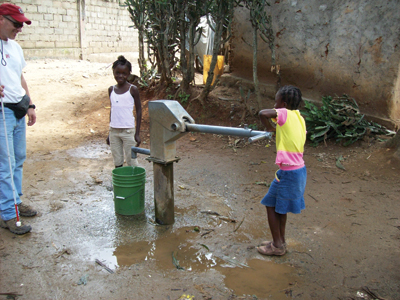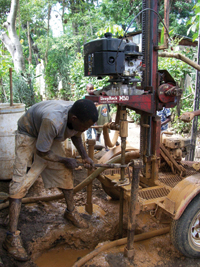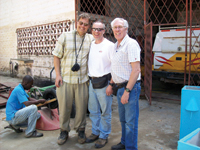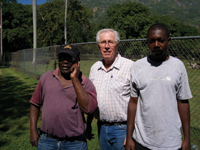
Features
Associations
Business
Lifewater Canada volunteers drill new wells, fix old in water-deprived Haiti
December 15, 2010 By James Careless
Even now, the scope of the Jan. 12, 2010, earthquake in Haiti staggers
the imagination. Over 217,000 people have died; some 300,000 more were
injured and one million left homeless. Some 250,000 homes and 30,000
commercial buildings were seriously damaged or destroyed.
Even now, the scope of the Jan. 12, 2010, earthquake in Haiti staggers the imagination. Over 217,000 people have died; some 300,000 more were injured and one million left homeless. Some 250,000 homes and 30,000 commercial buildings were seriously damaged or destroyed.
 |
| Rehabilitated well with new Afridev pump providing safe water for a village swelling with refugees from the earthquake. Photo courtesy of Mary Jane Conboy, OGWA. Advertisement
|
Water was in short supply before the earthquake. Afterwards, the shortage became worse. Today, most of Haiti’s nine million residents have no access to piped water, relying instead on shallow open wells that are often polluted. To add insult to injury, the relatively few deep wells that do exist can take hours to walk to, and require more hours standing in line for a turn at the tap.
Lifewater Canada is a group of Canadian ground water volunteers who are committed to addressing this problem in Haiti and other Third World countries. Lifewater was co-founded by Ontario government Senior Hydrogeologist Jim Gehrels. He was profoundly moved in 1994 by an African pastor who said that it was pointless to talk to people about God’s love when they were dying from water-borne disease. Gehrels responded with equipment and training, and has now been to Africa some 16 times, helping drill over 300 wells in Liberia, West Africa; even while a civil war, powered by child soldiers, raged over blood diamonds. “I use my vacation time and personal money to work in humanitarian disaster zones because I believe that everyone is created equal in God’s image,” he explains. “Whether a child lives or dies should not depend on where they are born.”
When the Jan. 12 earthquake struck, Gehrels was contacted by Alberta well driller Les Babcock to decide what could be done to help Haitians. Babcock has been travelling to Haiti as a volunteer since the 1980s. “My wife was a nurse in Haiti, and when I was there with her, I realized that 50 per cent of the recurring diseases she was treating were due to dirty water,” Babcock tells Ground Water Canada magazine. “That’s what got me drilling wells there and joining Lifewater. We all believe that clean water is vital for human health and survival, and we are willing to go to great lengths to get it to them.”
 |
|
| A young Haitian driller works on a well. Photo courtesy of Mary Jane Conboy, OGWA.
|
A quick dispatch
Five days after the earthquake, Gehrels and Babcock were on a flight to Santiago, in the neighbouring country of Dominican Republic. Once on the ground, they could feel the aftershocks still taking place in Port-au-Prince, more than 100 kilometres to the west. Undeterred, the two men hired a bus, filled it with water, food and medical supplies and headed to Haiti.
“When we got to Port-au-Prince, we were surprised to find out that many of the aqueducts were still operating, and that water demand had dropped dramatically due to people leaving the city,” Babcock says. “They (the Haitians) were heading up north to the Cap-Haitien region; a city that itself had been heavily damaged by an earthquake in 1842.”
From a water supply standpoint, this exodus was bad news. Accessible potable water was already scarce in the north: Adding millions of thirsty refugees to the mix would only make matters worse. So Gehrels and Babcock decided to head north themselves, after distributing bio-sand water filters in Port-au-Prince. Their goal was both to drill new wells and repair old ones, to offset the growing water crisis.
 |
|
| After drilling two wells in Haiti, (left to right) Brian Oddgard (Minnesota), Jim Gehrels (Ontario) and Les Babock (Alberta), celebrate both wells being successful. Photo courtesy of Mary Jane Conboy, OGWA.
|
Challenges
Ironically, there is lots of good ground water in Haiti, as long as you dig down about 90 to 110 feet. But you cannot do this with a backhoe or shovels, because polluted shallow aquifers could contaminate any deep wells you dig.
This is where Lifewater Canada comes in. Using older drilling rigs shipped from outside the country – “they are old to us, but new to the Haitians,” Gehrels says – these volunteers drill small diameter wells. They fit these wells with contamination-resistant PVC piping and robust hand pumps that can survive decades of use.
In just 17 days in post-earthquake Haiti, Gehrels and Babcock drilled three new wells and fixed five existing ones. In doing so, they ensured that thousands of refugees and local residents have access to potable water. This team also forestalled the chance of a catastrophic water shortage: in this case, if one hand-pumped well stops functioning, the diversion of people to other hand pumps can cause them to be overused and thus fail too.
The need remains
Lifewater Canada’s well drilling has helped ease the Haitian water crisis to a degree, but the overall problem remains. To survive, thrive and bring their country out of centuries of disease and poverty, all Haitians need access to clean water – and ground water wells are the most economical, accessible and reliable way to provide it to them.
 |
|
| Les Babcock (centre) is joined by a Lifewater driller and a trained pump repair technician. Photo courtesy of Mary Jane Conboy, OGWA.
|
“Right now, we are having a container of hand pumps built in India – you can’t get them in Canada – and readied for shipping to Haiti,” says Gehrels. “Meanwhile, we have got a mud rotary rig ready to ship and we are hoping for suppliers willing to donate 200 lengths of four-inch Sch. 40 PVC casing and 50 lengths of #10 slot well screen with centralizers; as well as four three-inch Grundfos pumps with generators to develop newly completed wells. Les is donating his cable tool rig, we have purchased a portable mud rotary rig and also two used army trucks that can move on all roads and in all weather conditions. But all of this costs money; even with the price breaks we have been able to negotiate. That’s why we need the continued financial support of the ground water community to make a difference in Haiti. We also need skilled volunteers to come for two- to three-week self-funded trips to aid in the work.”
For those considering volunteering, Lifewater Canada estimates that a two- to four-week trip will cost about $2,000. Volunteers are needed to GPS-locate existing wells, test water and well condition, plus determine well and water level depths. The ability to speak French is not a must, but would definitely be of help in French-speaking Haiti. Creole is even more useful.
Despite the value of Lifewater Canada’s efforts, the equipment price tag is surprisingly low. The container of hand pumps will likely cost about $50,000, including ship-borne transportation to Haiti. The mud rotary rig is $20,000. The charity can buy some rebuilt 6×6 ex-Army trucks for moving through Haiti’s rough terrain for $10,000 a piece. They are also seeking a Suzuki-sized small SUV, to move crews around the country.
“We are looking for financial help wherever we can, either large or small donations – it all helps,” Gehrels says. “It is possible to sponsor one of our projects in Haiti for $2,000 to $3,000. For this money, you will end up providing a community with life-giving ground water. But whatever you give, the good you can do is incalculable. That’s how important clean water is in Haiti.”
To find out how to help Lifewater Canada in Haiti and to donate time and money, go to www.lifewater.ca
Print this page